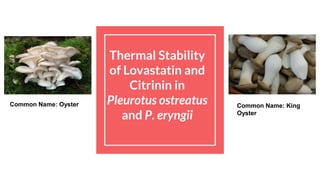
Citrinin_Lovastatin Thermal Stability in Mushrooms
- 1. Thermal Stability of Lovastatin and Citrinin in Pleurotus ostreatus and P. eryngii Common Name: Oyster Common Name: King Oyster Common Name: Oyster Common Name: King Oyster
- 2. Experiment Significance This experimental procedure stemmed from an original study concerning the presence of the cholesterol lowering organic compound lovastatin and mycotoxin citrinin in red yeast rice Pleurotus ostreatus (oyster) and P. eryngii (king oyster), both commercially cultivated fungi, also contain lovastatin and citrinin Both are typically roasted (in oil) before consumption, necessitating an analysis of the thermal stability of lovastatin and citrinin Temperature of complete citrinin dissipation is of particular interest
- 3. Citrinin- C13H14O5 Citrinin was first isolated as a pure compound from a culture of Penicillium citrinin in 1931. A nephrotoxic mycotoxin that is produced by several fungal species as well as many cereals and barley usually found with another mycotoxin called Ochratoxin A. In early studies, citrinin has been found to have strong antibacterial properties, but was ruled out upon discovering its potential to target and damage the kidneys in the form of fatty infiltration that cause the kidneys to swell and followed by eventual necrosis. The objective of our research is to find and decompose the citrinin without also
- 4. Lovastatin- C24H36O5 A lactone metabolite and common prodrug (metabolized into pharmaceutically active form after consumption) Inhibits the HMG-CoA reductase, an enzyme which increases the rate of mevalonate production within the biosynthetic pathway of cholesterol Experiment intends to analyze the extent (if any) of thermal decomposition of lovastatin in samples
- 5. Cooking Gather dry oyster and king oyster mushrooms. Soak dry mushrooms in water for 20 minutes, drain and toss them in oil. Place them on a piece of aluminum foil and insert them in the oven at 325℉. The samples were removed at 5-minute intervals. (5-min, 10-min, 15-min, and 20- min.) To stop additional cooking, place the hot mushrooms onto a pan resting in an ice bath to rapidly drop the temperature. Once cooled, wrap the mushrooms with a paper towel and place them in a Zip-
- 6. Extractions: 1. Rinse mushroom samples cooked in oil with Hexane twice. 2. Add a small amount of mushroom sample and 8:2mL Methanol-Water solution in a test tube. 3. The test tubes were placed in the sonicator for 15 minutes. 4. Once done, the solution goes through vacuum filtration. Approximately 5-mL of distilled water was used to rinse.
- 7. 5. The extracted liquid solution was placed in a separatory funnel. 6. Add 15-mL of Dichloromethane (Methyl Chloride) 7. Shake the separatory extractor and release the built up pressure. Repeat 3 times. Let it settle. 8. Extract the bottom layer into a 50-mL Erlenmeyer flask and place stopper. 9. Repeat step 6 - 8 for a second extraction. 10. Repeat steps 6 - 9 for every sample.
- 8. 11. The solutions collected in the Erlenmeyer flasks were placed in a 100-mL beaker which was then placed in a hot water bath. 12. We allowed the solution to evaporate completely in order to perform TLC.
- 9. Thin-Layer Chromatography (TLC) On the HPTLC plate, lightly mark a line using a pencil about 1 inch from the bottom going across the plate. Add 2 drops of dichloromethane into the evaporated solution beaker. Swirl around and then using 1-5 microliter pipette, collect the sample and spot it on the HPTLC plate. Do this for each sample.
- 10. On the plates… Plate 1: Citrinin and Lovastatin control dry oyster and king control oil oyster and king 325℉ oil oyster at 5, 10, 15, 20 minutes. 325℉ oil king at 5, 10, 15, 20 minutes Plate 2: Citrinin and Lovastatin control dry oyster and king control oil oyster and kind 425℉ oil oyster at 5, 10, 15, 20 minutes 425℉ oil king at 5, 10, 15, 20 minutes
- 11. In the chamber... Place the plates into the TLC chamber with the TLC solution and cover. Allow the solution to travel up the plates. Once the solution is all the way to the top, place the plates under the fume hood to dry.
- 12. In the light. Once dry, shine a short wavelength UV light and then a long wavelength UV light to see results.
- 13. Analysis Results: At both experimental temperatures, Lovastatin was still present and Citrinin decomposed. These results are positive because Lovastatin has beneficial properties and Citrinin has negative properties.
- 14. Conclusion - Utilized an existing, validated extraction procedure - TLC solution proved our uncertainty of how much citrinin is remaining. Lovastatin is still in the remaining sample. - This knowledge will aid in future issues with consumption - Found that heating (with oil) helps remove citrinin, but does not affect the levels of Lovastatin remaining